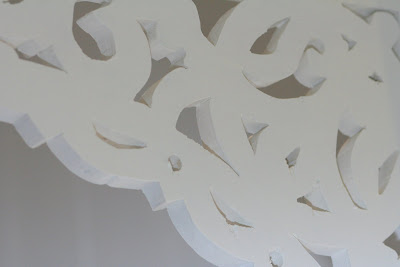Friday, 21 November 2008
Monday, 10 November 2008
Of Paphs and Vanilla
To nonchanantly throw around the name "paph" is a risky thing. You run into the possibility that serious gardeners will mistake you for one of their own and then you will be tragically, out of your depth. I am making tentative steps towards growing "paphs" or PAPHIOPEDILUM (say it: paf-ee-oh-ped-i-lum...the Slipper Orchid), I am now the proud owner of Paph. Maudiae; who like a true slippered-lady, is most kind and tolerant of learners. She has come home with a striking flower just to cut a little style.
The pictures really do not do justice to the beauty of this flower. I suspect that I may be a true slipper-lover but it remains to be seen whether the feeling will be reciprocated. Growing conditions are quite similar to phaleonopsis.
Unfortunately I have never been successful because I still do not have a proper orchid house.
 So it was with a certain amount of vicarious-ness that I brought Miss Slipper home. At the moment she is ensconced on my windowsill, keeping company with my fussy ferns. I hope they make her feel welcome and reassure her that it is not my intention to kill her!
So it was with a certain amount of vicarious-ness that I brought Miss Slipper home. At the moment she is ensconced on my windowsill, keeping company with my fussy ferns. I hope they make her feel welcome and reassure her that it is not my intention to kill her! As the rainy season is coming to an end, I will try with tomatoes again. I find growing them in the rain a useless and frustrating exercise. But I had fairly good results last year so I shall try again.
As the rainy season is coming to an end, I will try with tomatoes again. I find growing them in the rain a useless and frustrating exercise. But I had fairly good results last year so I shall try again.
 Do not be fooled by the casual nonchalance of this leaf. It is the shy VANILLA plant. Apparently it is likely that I shall have to hand-pollinate to get a pod, but I am willing to dress up as a large insect if the prize is a vanilla pod.
Do not be fooled by the casual nonchalance of this leaf. It is the shy VANILLA plant. Apparently it is likely that I shall have to hand-pollinate to get a pod, but I am willing to dress up as a large insect if the prize is a vanilla pod.
Posted by
My Chutney Garden
at
07:38
2
comments
![]()
Labels: Paph. Maudiae, vanilla plant
Monday, 3 November 2008
The Interior of Memory
Trinidad's vernacular architecture is a reflection of its patchwork history. The only true indigenous architecture is probably the Ajoupa which was well established by the Amerindians by the time Columbus did his discovery dance on the shores of southern Trinidad. The Ajoupa was made of forest wood and covered in palm or carat leaves. But the most beloved of all the local architectural styles would still have to be The Gingerbread House design with its extensive fretwork and high ceilings.
The world of the fretwork and jalousied house provides the shadows and interesting crannies that make for the magical feel of these old homes.

According to John Newel Lewis's Ajoupa. Architecture of the Caribbean. Trinidad's Heritage Republic of Trinidad and Tobago:
 Nowaways some designers expect the glass louvre to do all this at once. It can't." p221
Nowaways some designers expect the glass louvre to do all this at once. It can't." p221
Posted by
My Chutney Garden
at
18:13
3
comments
![]()
Labels: Gingerbread Houses in Trinidad
Sunday, 2 November 2008
Painting the Flowers
Trinidad has a very active art scene.

The vibe with this group is always lovely 
 Peter Sheppar is a well respected artist in both local and regional circles. He is best known for his richly detailed miniatures.
Peter Sheppar is a well respected artist in both local and regional circles. He is best known for his richly detailed miniatures.
Beverley Fitzwilliam Harries and Carolyn Lewis at work

Peter's different piece, I would challenge anyone to identify this as a Peter Sheppard.
 A bank of anthuriums
A bank of anthuriums
A nationalistic bromeliad
 ART HAPPENINGS
ART HAPPENINGS


*Event dates subject to change. Please verify the event you are interested in with respective Gallery.
Posted by
My Chutney Garden
at
13:59
2
comments
![]()
Labels: Artists in Trinidad
Saturday, 1 November 2008
Lapeyrouse Cemetery
 Lapeyrouse Cemetery's span is apparent from the 21st floor of the new Nicholas Tower in downtown Port of Spain. It lies north east of Victoria Square; two city blocks west of the savannah.
Lapeyrouse Cemetery's span is apparent from the 21st floor of the new Nicholas Tower in downtown Port of Spain. It lies north east of Victoria Square; two city blocks west of the savannah. This afternoon it is lively and busy with industrious grave painters;
This afternoon it is lively and busy with industrious grave painters; flower arrangement vendors;
flower arrangement vendors; and devoted family members for even though today is November 1st, the fading light is dotted with the soft glow of candles lighted to celebrate the memory of the dead.
and devoted family members for even though today is November 1st, the fading light is dotted with the soft glow of candles lighted to celebrate the memory of the dead. (All Soul's Day (sometimes called the "Day of the Dead") is always November 2 (November 3rd if the 2nd falls on a Sunday). All Soul's Day is a Roman Catholic day of remembrance for friends and loved ones who have passed away.http://all-souls-day.123holiday.net/
(All Soul's Day (sometimes called the "Day of the Dead") is always November 2 (November 3rd if the 2nd falls on a Sunday). All Soul's Day is a Roman Catholic day of remembrance for friends and loved ones who have passed away.http://all-souls-day.123holiday.net/ This comes from the ancient Pagan Festival of the Dead, which celebrated the Pagan belief that the souls of the dead would return for a meal with the family. http://all-souls-day.123holiday.net/
This comes from the ancient Pagan Festival of the Dead, which celebrated the Pagan belief that the souls of the dead would return for a meal with the family. http://all-souls-day.123holiday.net/ This cemetery mirrors our society with extraordinary parallels. It is rich with history and stranger-than-fiction tales told by mossy headstones. It is laid out, like Port of Spain, in an organised grid pattern. So that in death, as in life, you are given an address. It's a reassuring thought and one that brings an odd sense of comfort.
This cemetery mirrors our society with extraordinary parallels. It is rich with history and stranger-than-fiction tales told by mossy headstones. It is laid out, like Port of Spain, in an organised grid pattern. So that in death, as in life, you are given an address. It's a reassuring thought and one that brings an odd sense of comfort. 
Walking through the wide avenues of this heavily populated city of the dead
 it is possible to trace the history of Port of Spain. Here on the right as you enter, are the Chinese graves with their Chinese writing.
it is possible to trace the history of Port of Spain. Here on the right as you enter, are the Chinese graves with their Chinese writing. On the left side of the main avenue is the large de Verteuil family crypt
On the left side of the main avenue is the large de Verteuil family crypt and down each avenue the histories beg to be told, each headstone a whole life lived.
and down each avenue the histories beg to be told, each headstone a whole life lived. The first occurence of cholera in Trinidad was in 1853. "For two frightening months the epidemic raged and there were over two thousand deaths in Port of Spain out of a population of about 20,000. Whole families were wiped out and almost one in five persons in Port of Spain caught the disease." P93 Voices in the Street -Olga Mavrogordato.
The first occurence of cholera in Trinidad was in 1853. "For two frightening months the epidemic raged and there were over two thousand deaths in Port of Spain out of a population of about 20,000. Whole families were wiped out and almost one in five persons in Port of Spain caught the disease." P93 Voices in the Street -Olga Mavrogordato. The last recorded outbreak of cholera was documented in 1865. It is said that the casualties of the cholera epidemic created this cemetery city. According to Olga Mavrogordato's Voices In the Street, "all the space from Richmond Street, between Tragarete Road and Fraser Street, as enclosed by a wall and called the Old Cemetery. It can be assumed that Lapeyrouse Cemetery came into being officially sometime after 1813. However it is recorded that there exists therein a headstone of one Jean Creteau who died in 1745. This shows that it must have been used as a cemetery during the Spainish occupation." P.20
The last recorded outbreak of cholera was documented in 1865. It is said that the casualties of the cholera epidemic created this cemetery city. According to Olga Mavrogordato's Voices In the Street, "all the space from Richmond Street, between Tragarete Road and Fraser Street, as enclosed by a wall and called the Old Cemetery. It can be assumed that Lapeyrouse Cemetery came into being officially sometime after 1813. However it is recorded that there exists therein a headstone of one Jean Creteau who died in 1745. This shows that it must have been used as a cemetery during the Spainish occupation." P.20 Lapeyrouse Cemetery has fallen into disrepair over the last half-a-century; a severe indictment on a society that allows its dead to languish in squalour. It is currently populated by tenacious goats and equally formidable vagrants.
Lapeyrouse Cemetery has fallen into disrepair over the last half-a-century; a severe indictment on a society that allows its dead to languish in squalour. It is currently populated by tenacious goats and equally formidable vagrants.
Posted by
My Chutney Garden
at
18:46
3
comments
![]()














